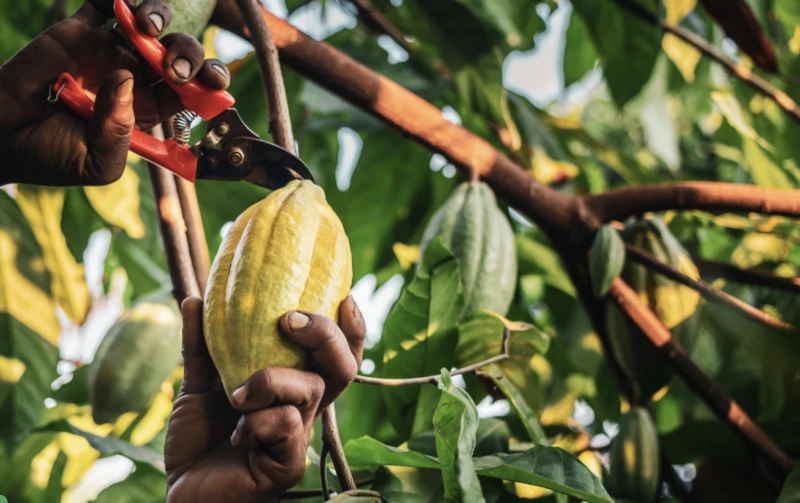Mars’ M&Ms and Snickers may soon produce its chocolate candies from cacao gene edited to withstand plant diseases and extreme heat
Mars’ M&Ms and Snickers may soon produce its chocolate candies from cacao gene edited to withstand plant diseases and extreme heat

Mars, Incorporated has licensed Pairwise’s Fulcrum® gene editing tools for cacao research and development. This licensing agreement grants Mars access to Pairwise’s CRISPR tools, including the SHARC™ enzyme. The Pairwise Fulcrum™ platform encompasses gene editing tools, enzymes and trait libraries, enabling precise changes that unlock the plant’s inherent potential. This capability significantly accelerates the development of impactful crop traits compared to traditional breeding methods, allowing for the activation or deactivation of characteristics and fine-tuning traits, much like adjusting a dimmer switch to achieve optimal results.
Mars aims to develop this advanced plant breeding technology to improve cacao production and effectively tackle agricultural challenges. The ultimate goal is to help address the pressures cacao faces globally from climate variability, plant diseases and environmental stresses. This strategic initiative underscores the potential of this technology to drive meaningful advancements in agriculture.
“At Mars, we believe CRISPR has the potential to improve crops in ways that support and strengthen global supply chains,” said Carl Jones, Plant Sciences Director at Mars. “Our focus is to transparently and responsibly conduct CRISPR research in plant science that helps crops better adapt to climate challenges, disease pressures and resource constraints.”
“We’re pleased to provide Mars with access to our Fulcrum™ platform for their cacao research and development initiatives,” said Ian Miller, Chief Operating Officer at Pairwise. “Plant breeding innovation has the potential to help address important agricultural challenges, and we look forward to supporting Mars’ research goals.”
The Pairwise Fulcrum® platform includes gene editing tools, enzymes and trait libraries, enabling precise changes that unlock the plant’s inherent potential to greatly accelerate the development of impactful crop traits compared to traditional breeding methods.
A version of this article was originally posted at Pairwise and is reposted here with permission. Any reposting should credit both the GLP and original article. Find Pairwise on X @PairwisePL
 | Videos | More... |

Video: Nuclear energy will destroy us? Global warming is an existential threat? Chemicals are massacring bees? Donate to the Green Industrial Complex!
 | Bees & Pollinators | More... |

GLP podcast: Science journalism is a mess. Here’s how to fix it

Mosquito massacre: Can we safely tackle malaria with a CRISPR gene drive?

Are we facing an ‘Insect Apocalypse’ caused by ‘intensive, industrial’ farming and agricultural chemicals? The media say yes; Science says ‘no’
 | Infographics | More... |

Infographic: Global regulatory and health research agencies on whether glyphosate causes cancer
 | GMO FAQs | More... |

Why is there controversy over GMO foods but not GMO drugs?

How are GMOs labeled around the world?

How does genetic engineering differ from conventional breeding?
 | GLP Profiles | More... |

Alex Jones: Right-wing conspiracy theorist stokes fear of GMOs, pesticides to sell ‘health supplements’





 Viewpoint — Fact checking MAHA mythmakers: How wellness influencers and RFK, Jr. undermine American science and health
Viewpoint — Fact checking MAHA mythmakers: How wellness influencers and RFK, Jr. undermine American science and health Viewpoint: Video — Big Solar is gobbling up productive agricultural land and hurting farmers yet providing little energy or sustainabilty gains
Viewpoint: Video — Big Solar is gobbling up productive agricultural land and hurting farmers yet providing little energy or sustainabilty gains Fighting deforestation with CO2: Biotechnology breakthrough creates sustainable palm oil alternative for cosmetics
Fighting deforestation with CO2: Biotechnology breakthrough creates sustainable palm oil alternative for cosmetics Trust issues: What happens when therapists use ChatGPT?
Trust issues: What happens when therapists use ChatGPT? 30-year-old tomato line shows genetic resistance to devastating virus
30-year-old tomato line shows genetic resistance to devastating virus California, Washington, Oregon forge immunization alliance to safeguard vaccine access against federal undermining
California, Washington, Oregon forge immunization alliance to safeguard vaccine access against federal undermining The free-range chicken dilemma: Better for birds, but with substantial costs
The free-range chicken dilemma: Better for birds, but with substantial costs ‘You have to treat the brain first’: Rethinking chronic pain with Sanjay Gupta
‘You have to treat the brain first’: Rethinking chronic pain with Sanjay Gupta
